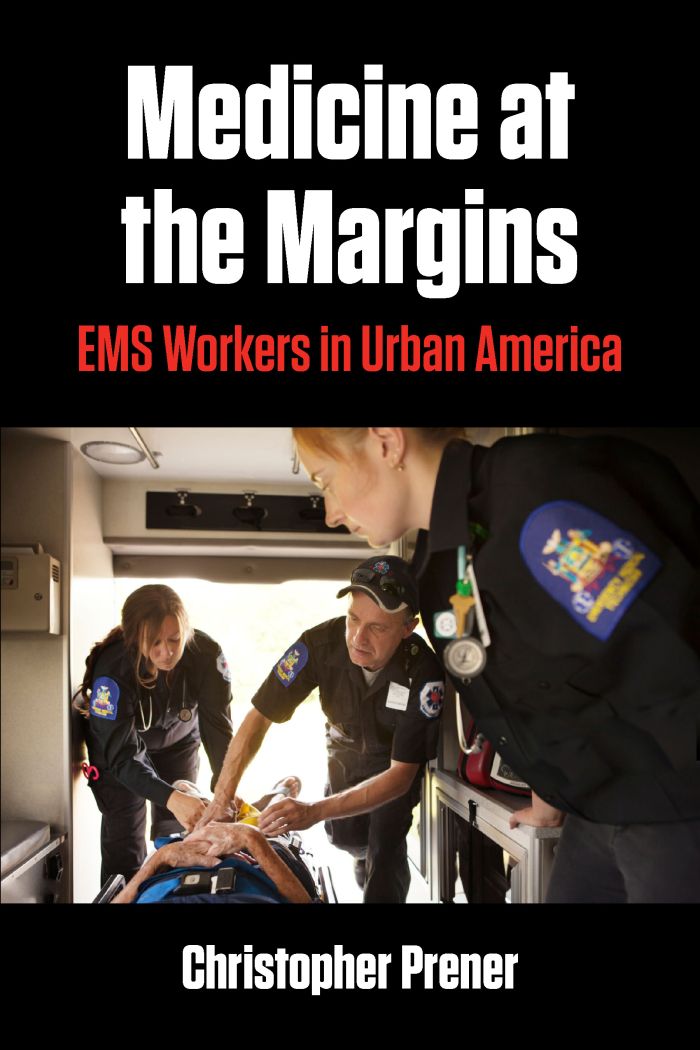Medicine at the Margins
EMS Workers in Urban America

This book can be opened with

Presents a unique view of social problems and conflicts over urban space from the cab of an ambulance.
While we imagine ambulances as a site for critical care, the reality is far more complicated. Social problems, like homelessness, substance abuse, and the health consequences of poverty, are encountered every day by Emergency Medical Services (EMS) workers. Written from the lens of a sociologist who speaks with the fluency of a former Emergency Medical Technician (EMT), Medicine at the Margins delves deeply into the world of EMTs and paramedics in American cities, an understudied element of our health care system.
Like the public hospital, the EMS system is a key but misunderstood part of our system of last resort. Medicine at the Margins presents a unique prism through which urban social problems, the health care system, and the struggling social safety net refract and intersect in largely unseen ways. Author Christopher Prener examines the forms of marginality that capture the reality of urban EMS work and showcases the unique view EMS providers have of American urban life. The rise of neighborhood stigma and the consequences it holds for patients who are assumed by providers to be malingering is critical for understanding not just the phenomenon of non- or sub-acute patient calls but also why they matter for all patients. This sense of marginality is a defining feature of the experience of EMS work and is a statement about the patient population whom urban EMS providers care for daily. Prener argues that the pre-hospital health care system needs to embrace its role in the social safety net and how EMSs’ future is in community practice of paramedicine, a port of a broader mandate of pre-hospital health care. By leaning into this work, EMS providers are uniquely positioned to deliver on the promise of community medicine.
At a time when we are considering how to rely less on policing, the EMS system is already tasked with treating many of the social problems we think would benefit from less involvement with law involvement. Medicine at the Margins underscores why the EMS system is so necessary and the ways in which it can be expanded.
Christopher Prener offers a razor-sharp analysis of social marginality through a case study of emergency medical services. Medicine at the Margins is an essential read not only for those interested in a growing “sociology of the ambulance,” but also those with broader interests in urban sociology, medical sociology, and the sociology of work.—Josh Seim, author of Bandage, Sort, and Hustle: Ambulance Crews on the Front Lines of Urban Suffering.
Medicine at the Margins is a deep dive into the world of EMS work that not only makes sense of that work in the intersection between medicine and our social safety net gaps, but also as productive of the urban landscape. Christopher Prener shows that EMS work helps to recreate our mental maps of the city, the kinds of people that we think live in them, and the kinds of resources we think they deserve. An excellent contribution.—Armando Lara-Millan, assistant professor of sociology at UC Berkeley, and author of Redistributing the Poor: Jails, Hospitals, and the Crisis of Law and Fiscal Austerity
Preface | ix
The Sociologist in the Ambulance | xi
A Note on Names and Places | xv
List of Abbreviations | xvii
Introduction: Shit Work on Urban America’s Front Lines | 1
The Scene | 23
PART I: EMS AS A MARGINAL INSTITUTION
1 Dial 9-1-1 for Emergencies | 37
2 The Ambulance Drivers Are Here! | 64
Conclusion | 89
PART II: EMS AS MARGINAL WORK
3 The Twenty-Four: The Rhythm of EMS Shifts | 93
4 Hurry Up and Wait: Passing Time and Avoiding Conflict | 112
Conclusion | 135
PART III: EMS IN THE MARGINAL CITY
5 The Daily Grind of Grunt Work | 139
6 Stigma and Space in Midtown | 162
Conclusion | 187
Marginality, Stigma, and the Future of Pre-Hospital Medicine | 189
Appendix: Notes on Data and Methods | 213
Acknowledgments | 227
Notes | 229
Works Cited | 241
Index | 263




